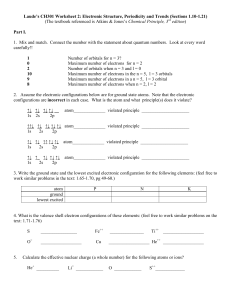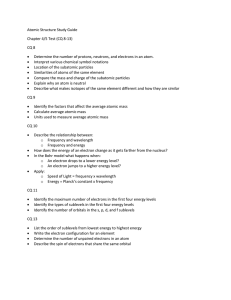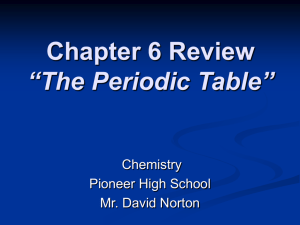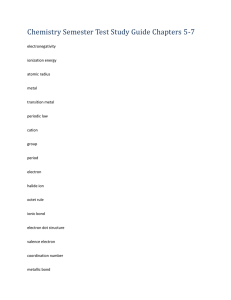Chemistry Review. Unit I. Atomic Structure and the Periodic Table
advertisement
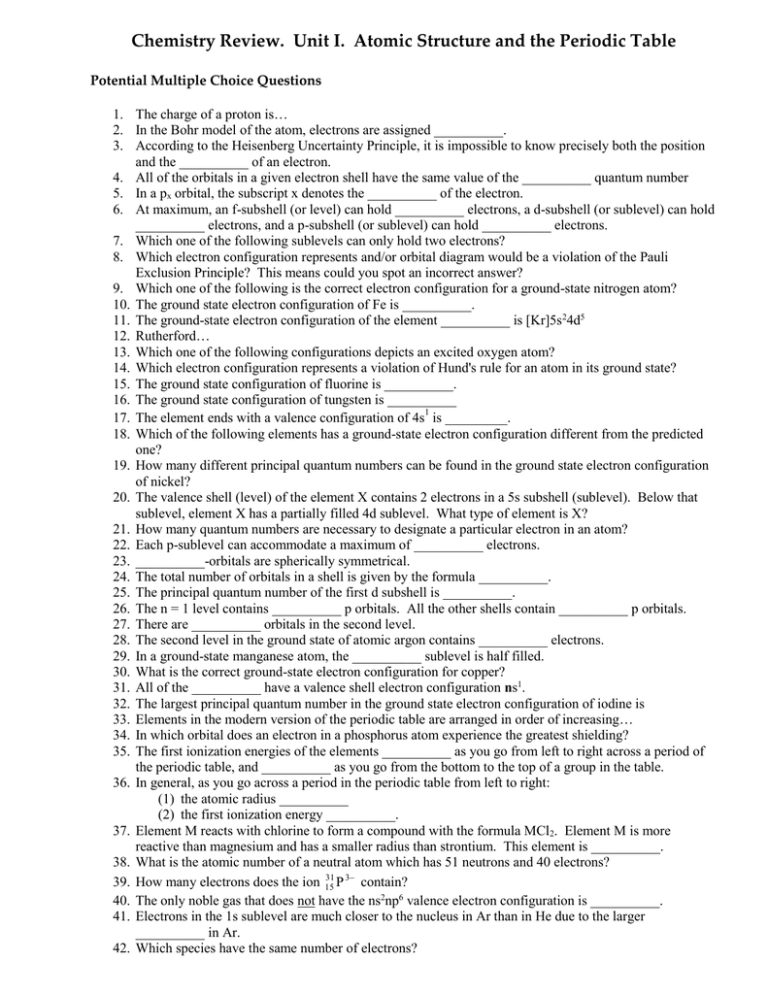
Chemistry Review. Unit I. Atomic Structure and the Periodic Table Potential Multiple Choice Questions 1. The charge of a proton is… 2. In the Bohr model of the atom, electrons are assigned __________. 3. According to the Heisenberg Uncertainty Principle, it is impossible to know precisely both the position and the __________ of an electron. 4. All of the orbitals in a given electron shell have the same value of the __________ quantum number 5. In a px orbital, the subscript x denotes the __________ of the electron. 6. At maximum, an f-subshell (or level) can hold __________ electrons, a d-subshell (or sublevel) can hold __________ electrons, and a p-subshell (or sublevel) can hold __________ electrons. 7. Which one of the following sublevels can only hold two electrons? 8. Which electron configuration represents and/or orbital diagram would be a violation of the Pauli Exclusion Principle? This means could you spot an incorrect answer? 9. Which one of the following is the correct electron configuration for a ground-state nitrogen atom? 10. The ground state electron configuration of Fe is __________. 11. The ground-state electron configuration of the element __________ is [Kr]5s24d5 12. Rutherford… 13. Which one of the following configurations depicts an excited oxygen atom? 14. Which electron configuration represents a violation of Hund's rule for an atom in its ground state? 15. The ground state configuration of fluorine is __________. 16. The ground state configuration of tungsten is __________ 1 17. The element ends with a valence configuration of 4s is _________. 18. Which of the following elements has a ground-state electron configuration different from the predicted one? 19. How many different principal quantum numbers can be found in the ground state electron configuration of nickel? 20. The valence shell (level) of the element X contains 2 electrons in a 5s subshell (sublevel). Below that sublevel, element X has a partially filled 4d sublevel. What type of element is X? 21. How many quantum numbers are necessary to designate a particular electron in an atom? 22. Each p-sublevel can accommodate a maximum of __________ electrons. 23. __________-orbitals are spherically symmetrical. 24. The total number of orbitals in a shell is given by the formula __________. 25. The principal quantum number of the first d subshell is __________. 26. The n = 1 level contains __________ p orbitals. All the other shells contain __________ p orbitals. 27. There are __________ orbitals in the second level. 28. The second level in the ground state of atomic argon contains __________ electrons. 29. In a ground-state manganese atom, the __________ sublevel is half filled. 30. What is the correct ground-state electron configuration for copper? 31. All of the __________ have a valence shell electron configuration ns1. 32. The largest principal quantum number in the ground state electron configuration of iodine is 33. Elements in the modern version of the periodic table are arranged in order of increasing… 34. In which orbital does an electron in a phosphorus atom experience the greatest shielding? 35. The first ionization energies of the elements __________ as you go from left to right across a period of the periodic table, and __________ as you go from the bottom to the top of a group in the table. 36. In general, as you go across a period in the periodic table from left to right: (1) the atomic radius __________ (2) the first ionization energy __________. 37. Element M reacts with chlorine to form a compound with the formula MCl2. Element M is more reactive than magnesium and has a smaller radius than strontium. This element is __________. 38. What is the atomic number of a neutral atom which has 51 neutrons and 40 electrons? 31 3 P contain? 39. How many electrons does the ion 15 40. The only noble gas that does not have the ns2np6 valence electron configuration is __________. 41. Electrons in the 1s sublevel are much closer to the nucleus in Ar than in He due to the larger __________ in Ar. 42. Which species have the same number of electrons? I. S2– Cl– II. III. Ne 43. Give the correct order for atomic radius for Mg, Na, P, Si and Ar. 44. The atomic radii of the alkali metals increase down a group because __________. 45. Which statement about the species 63Cu2+ and 65Cu+ is correct? 46. Of the following elements, which has the largest first ionization energy? 47. Which property decreases down group 17 in the periodic table? 48. Which of the following is an isotope of 24 12 Mg? 49. Which properties of the alkali metals decrease going down group 1? 50. An element is in group 14 and period 3 of the periodic table. How many electrons are in the highest occupied energy level of an atom of this element? 51. Which group on the periodic table has the lowest first ionization energies? 52. How many protons, neutrons and electrons are present in each atom of 31P? 53. 54. 55. 56. 57. 58. 59. 60. 61. 62. 63. 64. Chlorine is much more apt to exist as an anion than is sodium. This is because __________. Sodium is much more apt to exist as a cation than is chlorine. This is because __________. Which one of the following is a metalloid? This element is more reactive than lithium and magnesium but less reactive than potassium. This element is… What is the order of increasing energy of the orbitals within a single energy level? Which property generally decreases across period 3? Which property increases down group 1? Which statements about period 3 are correct? I. The electronegativity of the elements increases across period 3. II. The atomic radii of the elements decreases across period 3. III. The chemical properties are the same across period 3. Hydrogen is unique among the elements because __________. Which ion below has the largest radius? Which statement about the numbers of protons, electrons and neutrons in an atom is always correct? Yes, an usual question but think of possible answers if a MC question. Deduce the numbers of protons and electrons in the K+ ion. “Written” Section 1. Deduce the numbers of protons and electrons in the K+ ion. (1) 2. The electron configuration of chromium can be expressed as [Ar]4sx3dy. (i) Explain what the square brackets around argon, [Ar], represent. (1) (ii) State the values of x and y. (1) Annotate the diagram below showing the 4s and 3d orbitals for a chromium atom using an arrow, and , to represent a spinning electron. (1) 4s 3d 3. Define the term first ionization energy. (2) 4. Distinguish between a continuous spectrum and a line spectrum. 5. Explain why the first ionization energy of magnesium is higher than that of sodium. (2) 6. Carbon and silicon belong to the same group of the periodic table. (a) Distinguish between the terms group and period in terms of electron arrangement. (2) (b) State the period numbers of both carbon and silicon. (1) 7. The periodic table shows the relationship between electron arrangement and the properties of elements and is a valuable tool for making predictions in chemistry. (i) Identify the property used to arrange the elements in the periodic table. (1) (ii) Outline two reasons why electronegativity increases across period 3 in the periodic table and one reason why noble gases are not assigned electronegativity values. (3) 8. Answer the questions below (i) Define the term first ionization energy of an atom. (2) (ii) Explain the general increasing trend in the first ionization energies of the period 3 elements, Na to Ar. (2) 9. Answer the questions below (i) Outline two reasons why a sodium ion has a smaller radius than a sodium atom. (2) (ii) Explain why the ionic radius of P3– is greater than the ionic radius of Si4+. (2) 10. Define the term relative atomic mass (Ar). (1) 11. Define the term mass number. 12. The graph of the first ionization energy plotted against atomic number for the first twenty elements shows periodicity. (i) Define the term first ionization energy and state what is meant by the term periodicity. (2) (ii) State the electron configuration of argon and explain why the noble gases, helium, neon and argon show the highest first ionization energies for their respective periods. (3) (iii) A graph of atomic radius plotted against atomic number shows that the atomic radius decreases across a period. Explain why chlorine has a smaller atomic radius than sodium. (1) (iv) Explain why a sulfide ion, S2–, is larger than a chloride ion, Cl–. (2) (v) Explain how information from this graph provides evidence for the existence of energy levels and sub-levels within atoms. (4)
